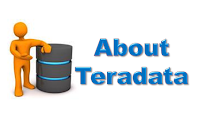What is the Teradata Database?
Teradata is a relational database management system (RDBMS) that is:
• Teradata is an open system, running on a UNIX MP-RAS or Windows server platform.
• Teradata is capable of supporting many concurrent users from various client platforms.
• Teradata is compatible with industry standards (ANSI compliant).
• Teradata is completely built on a parallel architecture.
Why Teradata?
There have plenty of reasons why customers like to choose Teradata .
Teradata is a relational database management system (RDBMS) that is:
• Teradata is an open system, running on a UNIX MP-RAS or Windows server platform.
• Teradata is capable of supporting many concurrent users from various client platforms.
• Teradata is compatible with industry standards (ANSI compliant).
• Teradata is completely built on a parallel architecture.
Why Teradata?
There have plenty of reasons why customers like to choose Teradata .
- Teradata supports more larger warehouse data than all competitors combined.
- Teradata Database can scale from 100 gigabytes to over 100+ petabytes of data on a single system without losing any performance .This is called Scalability.
- Provides a parallel-aware Optimizer that makes query tuning unnecessary to get a query to run.
- Automatic and even data distribution eliminates complex indexing schemes or time-consuming reorganizations .
- Teradata Database can handle the most concurrent users, who are often running multiple, complex queries.
- Designed and built with parallelism.
- Supports ad-hoc queries using SQL
- Single point of control for the DBA (Teradata Manager).
- Unconditional parallelism (parallel architecture)
- Teradata provides the lowest total cost (TCO) of ownership
- High availability of data because there is no single point of failure - fault tolerance is built-in to the system.
Teradata Database can be used as
- Enterprise data warehousing
- Active data warehousing
- Customer relationship management
- Internet and EBusiness
- Data marts





